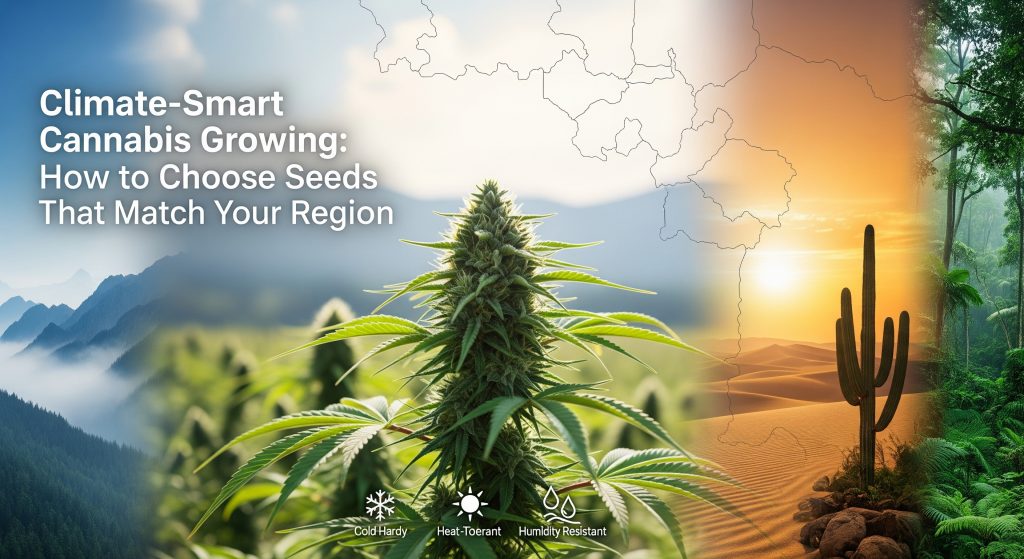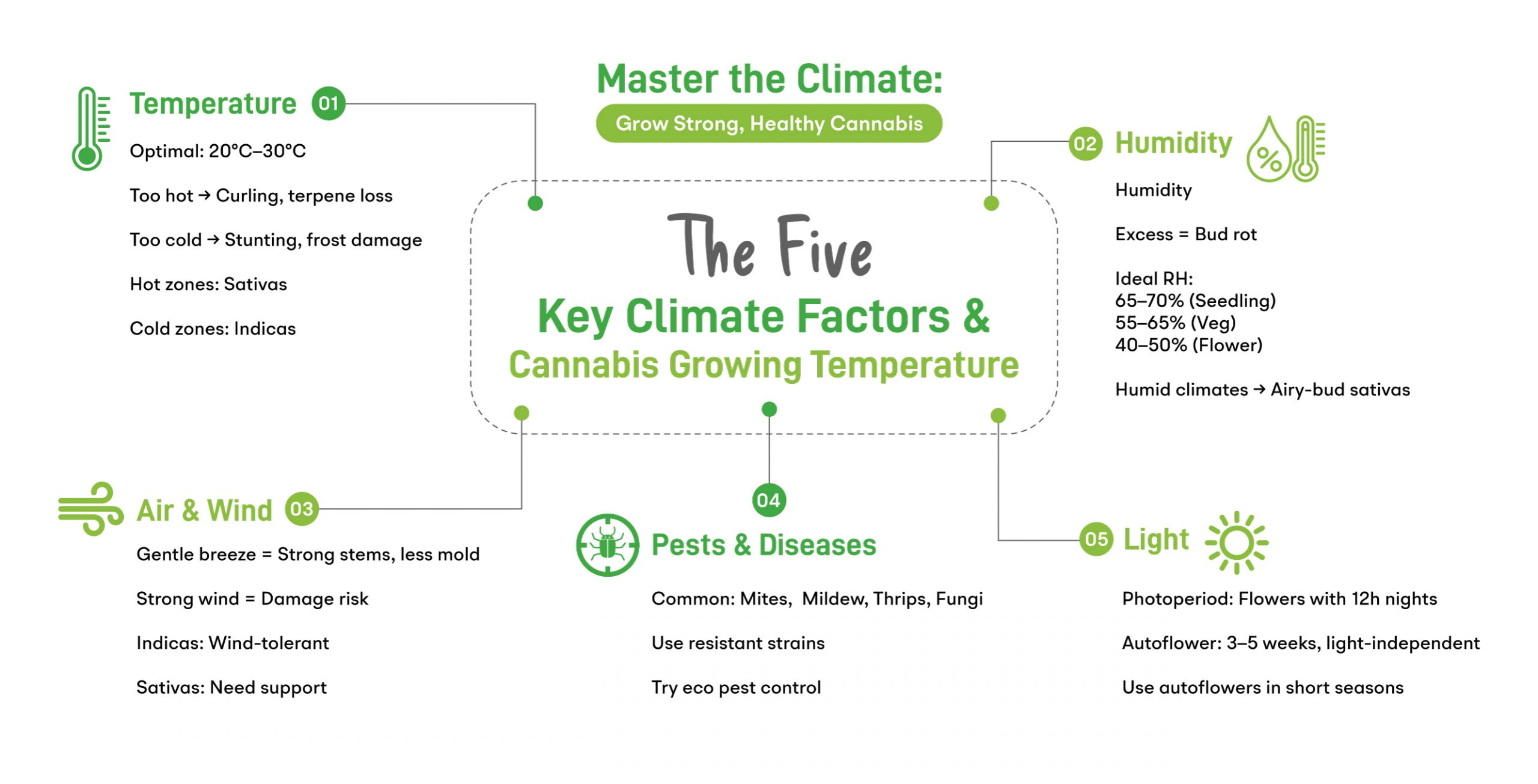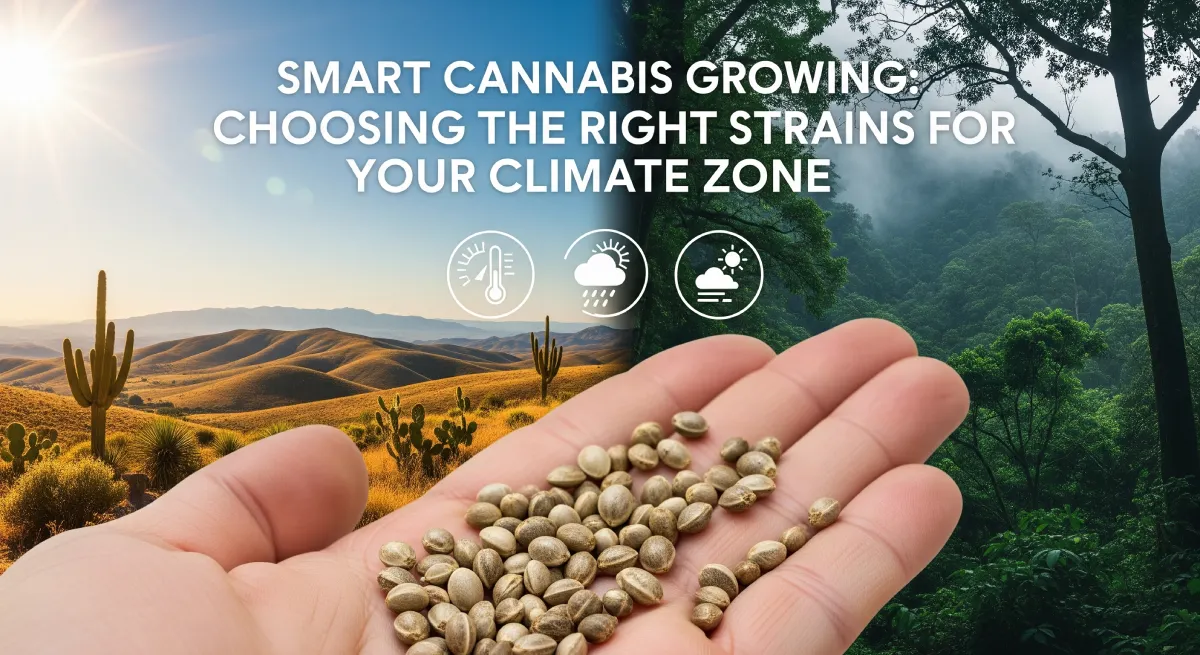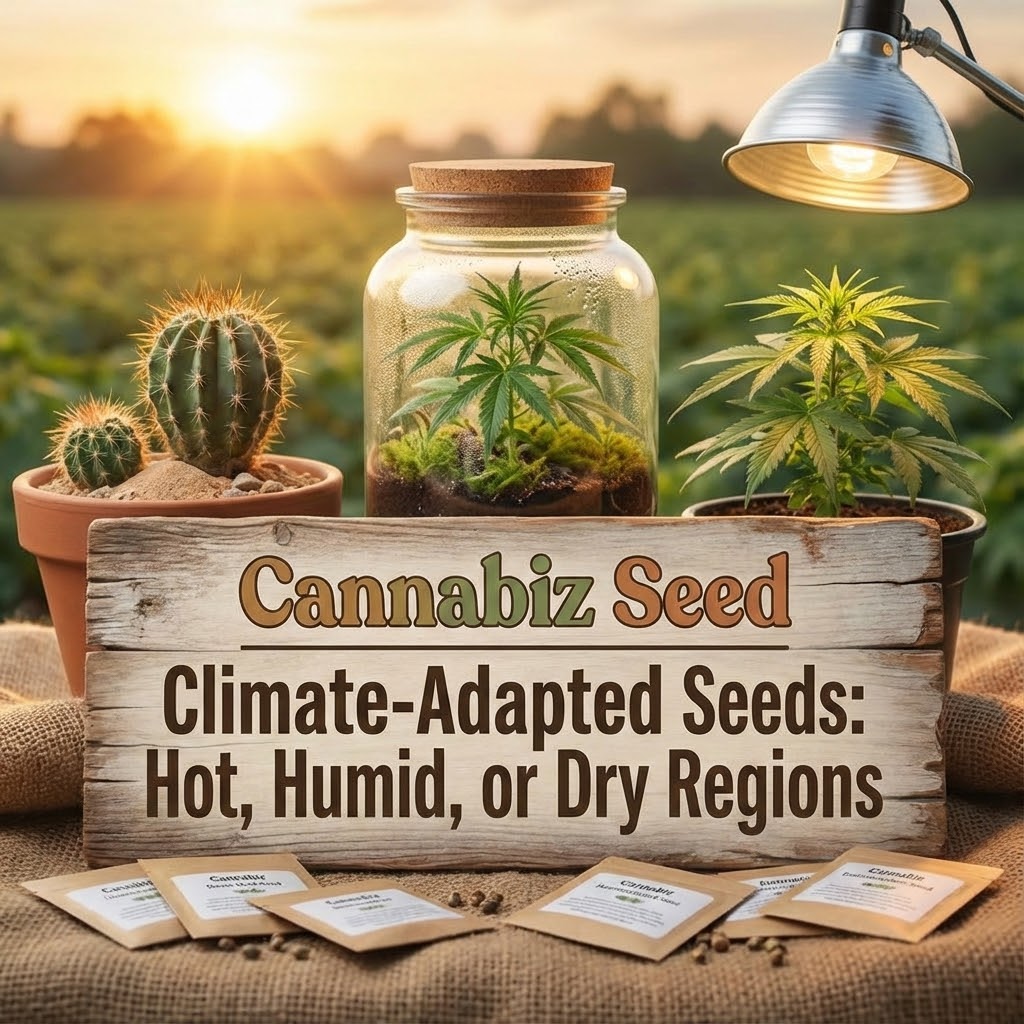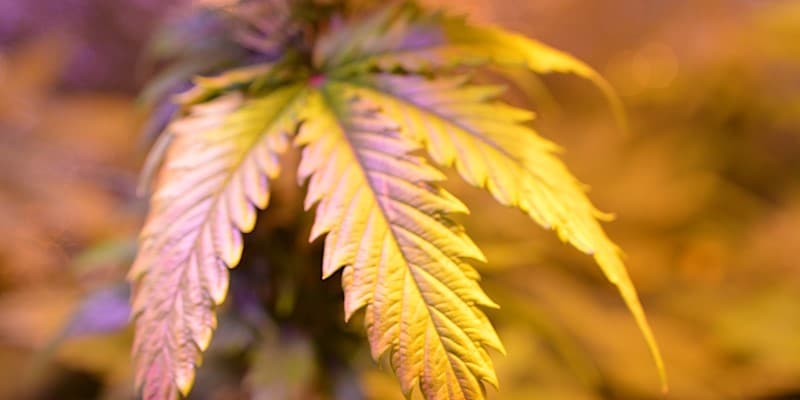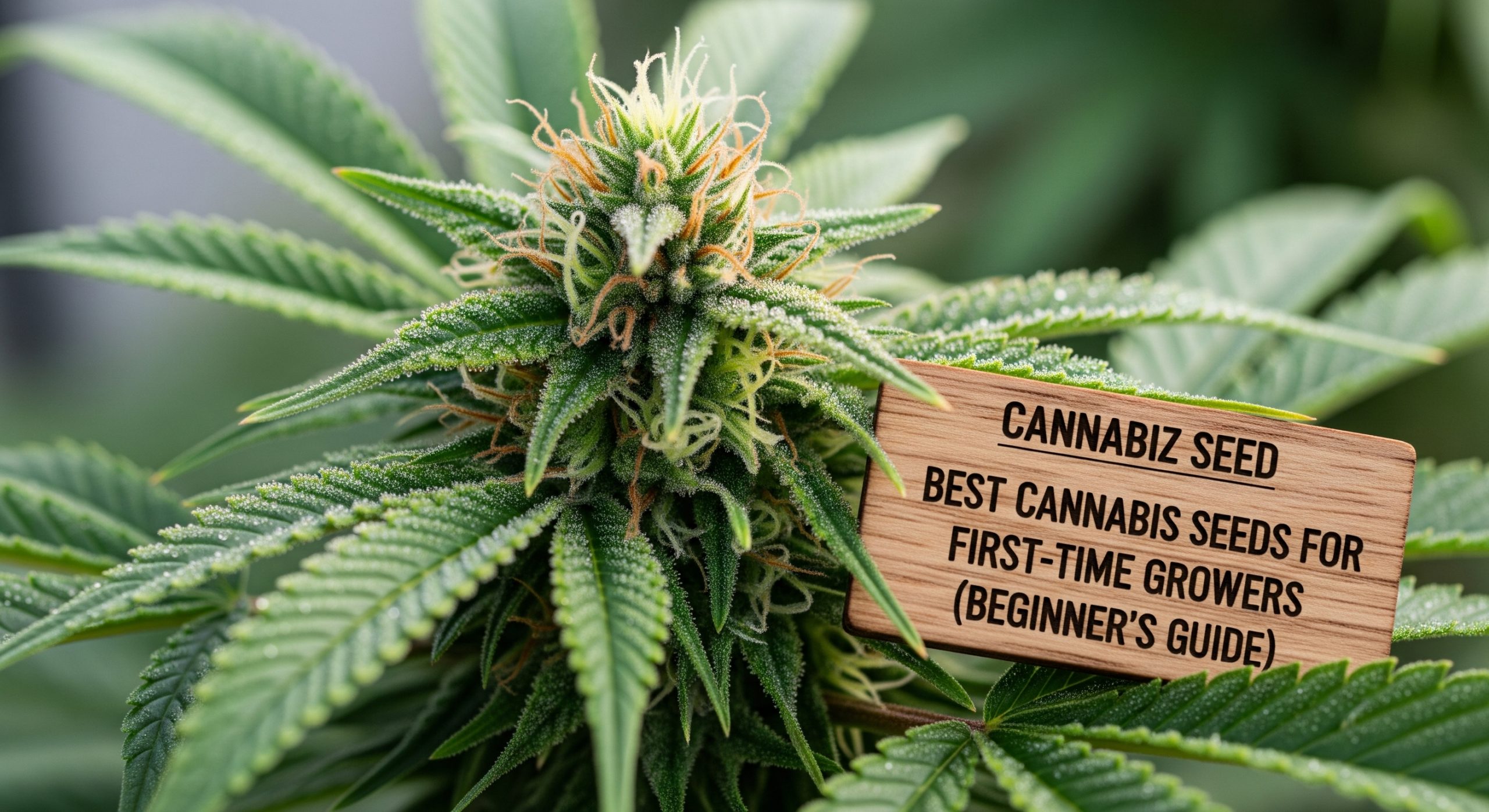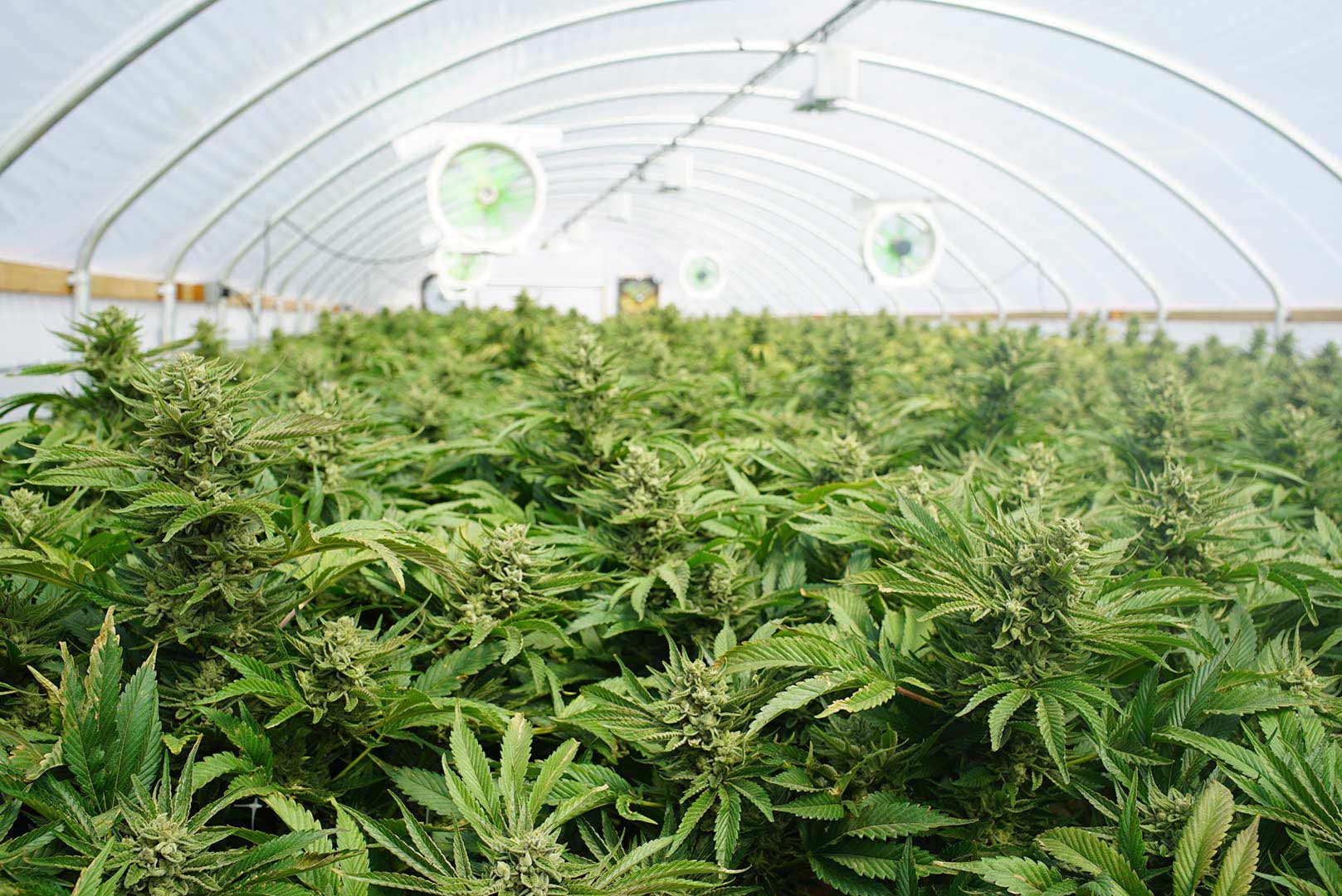Cultivo de cannabis adaptado al clima: Cómo elegir las semillas adecuadas para su región
Cuando se trata de cultivar cannabis en exterior, la compatibilidad climática separa una cosecha abundante de un cultivo decepcionante. Por eso este artículo te ayuda a entender las semillas de cannabis en relación con las zonas y condiciones climáticas.
Los cinco factores climáticos clave y el cultivo de cannabis
Temperatura
La mayoría de las plantas de cannabis prosperan en un rango de temperaturas de 20°C a 30°C. Cuando las temperaturas son demasiado altas, es probable que notes hojas rizadas, un crecimiento más lento e incluso pérdida de terpenos. Por el contrario, las temperaturas bajo cero pueden provocar un retraso del crecimiento o incluso la muerte por heladas.
Para climas cálidos, la genética sativa suele ser la mejor elección. Estas cepas son originarias de zonas ecuatoriales cálidas y pueden soportar altas temperaturas con facilidad.
Las genéticas índicas son una buena opción para las zonas de clima más frío. Se adaptan bien a las regiones montañosas, lo que las hace más resistentes a las heladas.
Humedad y precipitaciones
La humedad puede ser un asesino silencioso, especialmente cuando los cogollos se vuelven gruesos. Durante la fase de floración, un exceso de humedad puede provocar la pudrición de los cogollos y, en última instancia, un rendimiento decepcionante.
Entonces, ¿cuánta humedad necesita una planta de marihuana?
- Semillero: 65-70% HR
- Veg: 55-65% HR
- Floración: 40-50% HR
En climas húmedos, es probable que tu búsqueda de semillas de cannabis resistentes al moho termine en sativas con estructuras de cogollos aireadas. Estas flores abiertas permiten el flujo de aire y reducen la acumulación de humedad.
Luz (fotoperiodo e intensidad)
Las plantas de cannabis de fotoperíodo no florecen en función de la edad. Por eso esperan hasta finales de verano o principios de otoño, cuando las noches alcanzan aproximadamente las 12 horas, para empezar a florecer.
Este patrón de floración funciona bien en regiones con estaciones largas. Sin embargo, en zonas con heladas tempranas, puede que los cogollos no se formen antes de la llegada del invierno. Es mejor que utilices semillas de cannabis autoflorecientes, ya que florecen en 3-5 semanas, independientemente de la luz.
Movimiento del aire y viento
Una brisa suave fortalece los tallos, minimiza el moho y disuade a las plagas. Sin embargo, los vientos fuertes pueden provocar quemaduras, ramas rotas o plantas volcadas.
Las variedades compactas y tupidas con dominancia Indica soportan mejor los vientos fuertes. Las sativas altas y larguiruchas pueden necesitar algún soporte estructural para evitar que el viento las derribe.
Plagas y enfermedades
Las zonas cálidas y húmedas atraen una gran variedad de plagas y enfermedades.
- Ácaros araña
- Oidio
- Thrips
- Infecciones fúngicas.
Los jardineros con conciencia ecológica recurren cada vez más a métodos naturales para controlar las plagas. En este caso, las variedades de cannabis resistentes a plagas y enfermedades constituyen una primera línea de defensa.
Cultivo inteligente de cannabis: Cómo elegir las variedades adecuadas para tu zona climática
Para muchos cultivadores de hierba en exterior, no es sólo un elemento el que está en juego. Hay que saber qué variedades se adaptan a los elementos combinados que definen zonas climáticas específicas en todo el mundo.
Climas tropicales (cálidos, húmedos y de estaciones largas)
Los climas tropicales ofrecen a los cultivadores temporadas de crecimiento más largas para cultivar variedades de floración más prolongada. Es probable que esto conduzca a mayores rendimientos. La principal preocupación es la elevada humedad, que conlleva un mayor riesgo de plagas y moho.
En este caso, la genética sativa dominante es beneficiosa porque su estructura alta y aireada permite una mejor circulación del aire y reduce la probabilidad de moho.
Climas secos (calurosos, áridos y soleados)
Los climas secos se caracterizan por un sol abrasador, precipitaciones mínimas y tormentas de polvo con las que lidiar. Sin embargo, su fuerte luz solar posee un valor significativo con la genética adecuada.
Las variedades de cannabis aptas para climas secos suelen ser híbridos con dominancia Indica adaptados al desierto. Estas plantas se caracterizan por sus gruesas capas de resina, que las protegen de la radiación UV y de la pérdida de humedad.
Climas templados (cuatro estaciones diferenciadas)
La rapidez con que cambia el tiempo es una de las muchas desventajas de un clima templado. Es más probable que los veranos sean cálidos, pero las heladas otoñales pueden llegar pronto.
- Los híbridos de floración rápida que combinan la velocidad de Indica con la resistencia al moho de Sativa funcionan mejor aquí.
- Con las semillas de cannabis Autoflower, puedes hacer dos cosechas antes de que llegue el otoño.
- Si quieres un mayor potencial de rendimiento del fotoperiodo, inicia tus semillas en interior antes de trasplantarlas al exterior cuando sea seguro.

Consejo de cultivo profesional: Siembra tus semillas en interior a principios de primavera para adelantarte a la temporada. Así, las plantas de fotoperiodo tendrán tiempo suficiente para desarrollarse completamente antes de salir al exterior tras las últimas heladas.
Climas continentales (oscilaciones extremas de temperatura)
Con veranos calurosos, inviernos fríos y un periodo vegetativo corto, las autoflorecientes son su mejor opción. Sus rápidos ciclos de 60-90 días permiten recoger una cosecha completa entre finales de primavera y mediados de verano. También puedes cultivarlas con fotoperiodo, pero asegúrate de elegir variedades de floración temprana.
Climas polares y subárticos (veranos cortos y fríos)
Si te encuentras por encima del paralelo 60 -partes de Alaska, Escandinavia o Siberia-, tu ventana de cultivo de cannabis en exterior es de unas 8-10 semanas.
En este caso, sólo las semillas de cannabis autoflorecientes tienen sentido. Están diseñadas para veranos cortos y no responden a cambios en el fotoperiodo.
Conclusión
Elegir las mejores semillas de cannabis significa trabajar con tu entorno, no contra él. Ninguna cantidad de nutrientes o equipamiento de lujo puede compensar una genética que simplemente no se adapta a tu zona.
